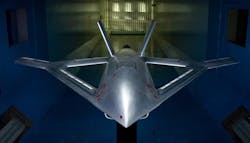Aurora moves forward in flight demonstration of next-generation active flow control for electric aircraft
ARLINGTON, Va. – Aerospace designers at Aurora Flight Sciences Corp. in Manassas, Va. are moving forward in flight demonstration for a project to push the bounds of future electric aircraft by eliminating control surfaces like ailerons, rudders, and flaps.
Officials of the U.S. Defense Advanced Research Projects Agency (DARPA) in Arlington, Va., announced a $41.4 million order to Aurora in December to continue with the second and third phases of the Control of Revolutionary Aircraft with Novel Effectors (CRANE) project.
This phase calls for Aurora Flight Sciences experts to test integrated subsystem components, and then carry out fabrication, assembly, ground test, and flight demonstration of an experimental CRANE electric aircraft.
This order is to exercise option 1 of the CRANE program's second and third phase, and brings the total cumulative face value of the contract to $89.6 million. Aurora won a $42.2 million contract in December 2022 for Crane program's second and third phases.
Related: Urban air mobility gaining traction
Instead of using ailerons, rudders, and flaps for control surfaces on future electric aircraft, the CRANE project seeks to use actuators or effectors to add energy or momentum to the flow of air over the aircraft. Essentially this approach uses puffs of air to change aircraft attitude.
Aurora engineers are trying to inject a disruptive technology early in aircraft design with new flow-control technologies and design tools. The idea is to configure and optimize an aircraft with active flow control to enhance efficiency and effectiveness of new commercial and military aircraft.
Passive control involves geometrical modifications like vortex generators on an aircraft wing for flow separation control, or chevrons on an exhaust nozzle of an aircraft to mitigate noise. Passive control devices always are on, no matter the need or performance penalty.
Active flow control, on the other hand, involves energy or momentum addition to the flow in a regulated manner. It is more desirable than passive control because aircraft pilots can turn it on or off as necessary.
Active flow control alters the aircraft's aerodynamic flow field through mechanical actuators, or by ejection or suction on a wing, fuselage, inlet, or nozzle.
Effectors and actuators typically are the enabling technologies of active flow control, yet have been the weakest link in developing active flow-control technology. Despite their relatively high costs, effectors and actuators typically are light weight, have no moving parts, and are energy-efficient.
Aurora is demonstrating new active flow control on an X-plane, with a focus on the best ways to develop and flight demonstrate their flow-control technologies on a clean-sheet design or modification of an existing aircraft.
Related: The quest for commercial-performance electronics in space
The CRANE project excludes large external moving surfaces like ailerons, rudders, flaps, elevators, and trim surfaces; mechanical vectoring of engine jet exhaust, or other traditional moving aerodynamic control devices.
CRANE's goal is to demonstrate in flight that active flow-control actuator technologies can maintain flight safely, and provide quantifiable aircraft capabilities.
On this order Aurora will do the work in Manassas, Va.; Cambridge, Mass.; Charleston, S.C.; Bridgeport, Conn.; Huntsville, Miss.; St. Louis; Huntington Beach, Calif.; Mesa, Ariz.; Fort Worth, Texas; National Harbor, Md.; and Salt Lake City, and should be finished in October 2025. For more information contact Aurora Flight Sciences online at www.aurora.aero, or DARPA at www.darpa.mil/program/control-of-revolutionary-aircraft-with-novel-effectors.
